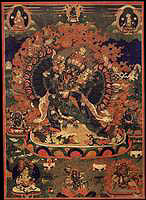
|
Tutelary Deity Yamantaka (painting no. 311)
|

View Larger Image |
||||||||||||||
|
Vajra Bhairava (Tibetan: dor je jig je, Eng.: Vajra Terror) and the consort Vajra Vetali (Tib.: dor je ro lang ma): the wrathful tantric form of Manjushri. Bhairava, blue-black in colour, has 9 faces, 32 hands and 16 legs. The main face is that of a buffalo, with a red face above and the slightly angry yellow face of Manjushri placed on top between the two flame tipped horns. The three right faces are yellow, blue and red and the three left are black, white and smoky. Each face has three large eyes, gaping mouths with frightful expressions; the dark yellow hair flows upward like flames. The first pair of hands hold a curved knife and skullcup held to the heart and embrace the consort Vajra Vetali (Tib.: dor je ro lang ma) - dark blue, one face and two hands. Adorned with a variety of ornaments and a necklace of fifty heads, the right legs are bent pressing down on a man, animals and various gods. The left legs are extended straight and press upon various birds and gods; standing above a sun disc and multi-coloured lotus completely surrounded by the orange flames of pristine awareness. Two skullcups in front, and one to the side are filled with various offerings of alcohol, nectar and the essence of the five senses. At the top center is the primordial buddha Vajradhara, dark blue, holding a vajra and bell crossed at the heart. To the left is lama Tsongkhapa performing the teaching gesture while holding the stems of two lotus blossoms supporting a sword and book. To the right is White Tara, goddess of longevity, with the right hand in the mudra of generosity and the left held to the heart, both hands hold the stem of a lotus flower. At the lower left is Sadbhuja Mahakala (the Great Black One with Six Hands), Avalokiteshvara emanating as Mahakala, dark blue in colour, very wrathful and surrounded by flames. At the right is the special protector of the Vajra Bhairava Tantras, Yama Dharmaraja, dark blue, with the head of a buffalo, holding a bone stick and lasso. Embraced by the consort Chamundi, he rides on the back of a buffalo; surrounded by flame. At the bottom center is Magzor Gyalmo, wrathful Sarasvati, with one face and two hands holding a stick and skullcup, riding a mule; surrounded by dark smoke. To the left is the guardian of the northern direction, Vaisravana, yellow in colour with one face and two hands holding a victory banner and a mongoose; riding a white snow lion. To the right is the worldly protector Setrap Chen, red in colour, wearing the silk pendent headdress and garb of a Tibetan warrior. Held in the right hand is a stick and in the left a lasso. Riding on the back of a horse he is surrounded by flames. As a tutelary deity Vajra Bhairava, also known as Yamantaka, belongs to the Yamari class of tantras and specifically arises from the Vajra Bhairava Root Tantra (Tibetan: jig je tsa gyu) and belongs to the method (father) classification of Anuttaryoga Tantra. The practice of Bhairava is common to the three Sarma Schools: Sakya, Kagyu and Gelugpa. There are numerous forms and styles of practice from the very complex mandalas with numerous deities to the very concise with a single Heruka form. The main lineages to enter Tibet were those of Jowo Atisha, Rwa Lotsawa, Mal Lotsawa and the like. This form of Bhairava with the central faces placed 3 vertically and 3 faces to each side arranged horizontally is unique to the Gelugpa School and true to a visionary experience of Lord Tsongkhapa the founder. Lineage: Shri Vajra Bhairava, Jnana Dakini, Mahasiddha Lalitavajra, Amoghavajra, Yeshe Jungne Bepa, Mahasiddha Padmavajra, Marmedze Srungwa, Rwa Lotsawa Dorje Drag, Rwa Chorab, Rwa Yeshe Senge, Rwa Bum Seng, Rongpa Gwalo Namgyal Dorje, Rongpa Sherab Senge, Lamdrepa Yeshe Palwa, Je Sonam Lhundrup, Choje Dondrup Rinchen, Je Tsongkhapa Lozang Trakpa (1357-1419), etc. Jeff Watt 9-98
|
|||||||||||||||
Photographed Image Copyright © 1998 Shelley & Donald Rubin Foundation
|
|
| |
Next Image |